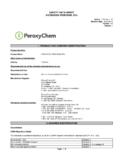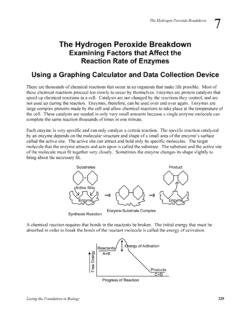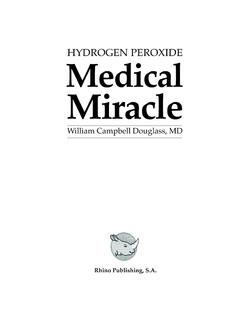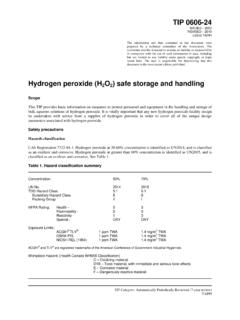Transcription of MATERIAL SAFETY DATA SHEET HYDROGEN PEROXIDE, …
1 MATERIAL SAFETY data SHEET HYDROGEN peroxide , 50% MSDS 1: Chemical Product and Company Identification Product Name: HYDROGEN peroxide , 50% Catalogue Codes: SLH1453 CAS#: Mixture. RTECS: Not applicable. TSCA: TSCA 8(b) inventory: Water; HYDROGEN peroxide CI#: Not applicable. Synonym: HYDROGEN peroxide , 50% Solution Chemical Name: Not applicable. Chemical Formula: Not applicable. 2: Composition and Information on Ingredients Composition: Name CAS # % by Weight Water 7732-18-5 50 HYDROGEN peroxide 7722-84-1 50 Toxicological data on Ingredients: HYDROGEN peroxide : ORAL (LD50): Acute: 2000 mg/kg [Mouse]. DERMAL (LD50): Acute: 4060 mg/kg [Rat]. 2000 mg/kg [ pig]. VAPOR (LC50): Acute: 2000 mg/m 4 hours [Rat].
2 3: Hazards Identification Potential Acute Health Effects: Very hazardous in case of skin contact (irritant), of eye contact (irritant). Hazardous in case of skin contact (corrosive, permeator), of eye contact (corrosive), of ingestion, Slightly hazardous in case of inhalation (lung sensitizer). Liquid or spray mist may produce tissue damage particularly on mucous membranes of eyes, mouth and respiratory tract. Skin contact may produce burns. Inhalation of the spray mist may produce severe irritation of respiratory tract, characterized by coughing, choking, or shortness of breath. Prolonged exposure may result in skin burns and ulcerations. Over-exposure by inhalation may cause respiratory irritation.
3 Inflammation of the eye is characterized by redness, watering, and itching. Skin inflammation is characterized by itching, scaling, reddening, or, occasionally, blistering. Potential Chronic Health Effects: CARCINOGENIC EFFECTS: Classified A3 (Proven for animal.) by ACGIH [ HYDROGEN peroxide ]. Classified 3 (Not classifiable for human.) by IARC [ HYDROGEN peroxide ]. MUTAGENIC EFFECTS: Mutagenic for mammalian somatic cells [ HYDROGEN peroxide ]. Mutagenic for bacteria and/or yeast. [ HYDROGEN peroxide ]. TERATOGENIC EFFECTS: Not available. DEVELOPMENTAL TOXICITY: Not available. The substance may be toxic to blood, upper respiratory tract, skin, eyes, central nervous system (CNS).
4 Repeated or prolonged exposure to the substance can produce target organs damage. Repeated or prolonged contact with spray mist may produce chronic eye irritation and severe skin irritation. Repeated or prolonged exposure to spray mist may produce respiratory tract irritation leading to frequent attacks of bronchial infection. 4: First Aid Measures Eye Contact: Check for and remove any contact lenses. In case of contact, immediately flush eyes with plenty of water for at least 15 minutes. Cold water may be used. Get medical attention immediately. Skin Contact: In case of contact, immediately flush skin with plenty of water for at least 15 minutes while removing contaminated clothing and shoes.
5 Cover the irritated skin with an emollient. Cold water may be used. Wash clothing before reuse. Thoroughly clean shoes before reuse. Get medical attention immediately. Serious Skin Contact: Wash with a disinfectant soap and cover the contaminated skin with an anti-bacterial cream. Seek immediate medical attention. Inhalation: If inhaled, remove to fresh air. If not breathing, give artificial respiration. If breathing is difficult, give oxygen. Get medical attention immediately. Serious Inhalation: Evacuate the victim to a safe area as soon as possible. Loosen tight clothing such as a collar, tie, belt or waistband. If breathing is difficult, administer oxygen. If the victim is not breathing, perform mouth-to-mouth resuscitation.
6 WARNING: It may be hazardous to the person providing aid to give mouth-to-mouth resuscitation when the inhaled MATERIAL is toxic, infectious or corrosive. Seek immediate medical attention. Ingestion: Do NOT induce vomiting unless directed to do so by medical personnel. Never give anything by mouth to an unconscious person. Loosen tight clothing such as a collar, tie, belt or waistband. Get medical attention if symptoms appear. Serious Ingestion: Not available. 5: Fire and Explosion data Flammability of the Product: Non-flammable. Auto-Ignition Temperature: Not applicable. Flash Points: Not applicable. Flammable Limits: Not applicable. Products of Combustion: Not available.
7 Fire Hazards in Presence of Various Substances: Of combustible materials Explosion Hazards in Presence of Various Substances: Explosive in presence of open flames and sparks, of heat, of organic materials, of metals, of acids. Fire Fighting Media and Instructions: Fire: Small fires: Use water. Do not use dry chemicals or foams. CO2, or Halon may provide limited control. Large fires: Flood fire area with water from a distance. Move containers from fire area if you can do it without risk. Do not move cargo or vehicle if cargo has been exposed to heat. Fight fire from maximum distance or use unmanned hose holders or monitor nozzles. Cool containers with flooding quantities of water until well after fire is out.
8 ALWAYS stay away from tanks engulfed in fire. For massive fire, use unmanned hose holders or monitor nozzles; if this is impossible, withdraw from area and let fire burn. / HYDROGEN peroxide , aqueous solution, with not less than 8% but less than 20% HYDROGEN peroxide ; HYDROGEN peroxide , aqueous solution, with not less than 20% but not more than 60% HYDROGEN peroxide (stabilized as necessary)/ [QC Reviewed] [ Department of Transportation. 2000 Emergency Response Guidebook. RSPA P Edition. Washington, : Government Printing Office, 2000, p. G-140] Special Remarks on Fire Hazards: Most cellulose (wood, cotton) materials contain enough catalyst to cause spontaneous ignition with 90% HYDROGEN peroxide .
9 HYDROGEN peroxide is a strong oxide. It is not flammable itself, but it can cause spontaneous combustion of flammable materials and continued support of the combustion because it liberates oxygen as it decomposes. HYDROGEN peroxide mixed with magnesium and a trace of magnesium dioxide will ignite immediately. Special Remarks on Explosion Hazards: Soluble fuels (acetone, ethanol, glycerol) will detonate on a mixture with peroxide over 30% concentration, the violence increasing with concentration. Explosive with acetic acid, acetic anhydride, acetone, alcohols, carboxylic acids, nitrogen containing bases, As2S3, Cl2 + KOH, FeS, FeSO4 + 2 methylpyridine + H2SO4, nitric acid, potassium permanganate, P2O5, H2Se, Alcohols + H2SO4, Alcohols + tin chloride, Antimony trisulfide, chlorosulfonic acid, Aromatic hydrocarbons + trifluoroacetic acid, Azelaic acid + sulfuric acid (above 45 C), Benzenesulfonic anhydride, tert-butanol + sulfuric acid, Hydrazine, Sulfuric acid, Sodium iodate, Tetrahydrothiophene, Thiodiglycol, Mercurous oxide, mercuric oxide, Lead dioxide, Lead oxide, Manganese dioxide, Lead sulphide, Gallium + HCl, Ketenes + nitric acid, Iron (II)
10 Sulphate + 2-methylpyridine + sulfuric acid, Iron (II) sulphate + nitric acid, + sodium carboxymethylcellulose (when evaporated), Vinyl acetate, trioxane, water + oxygenated compounds ( : acetaldehyde, acetic acid, acetone, ethanol, formaldehyde, formic acid, methanol, 2-propanol, propionaldehyde), organic compounds. Beware: Many mixtures of HYDROGEN peroxide and organic materials may not explode upon contact. However, the resulting combination is detonatable either upon catching fire or by impact. EXPLOSION HAZARD: SEVERE, WHEN HIGHLY CONCENTRATED OR PURE H2O2 IS EXPOSED TO HEAT, MECHANICAL IMPACT, OR CAUSED TO DECOMPOSE CATALYTICALLY BY METALS & THEIR SALTS, DUSTS & ALKALIES.







